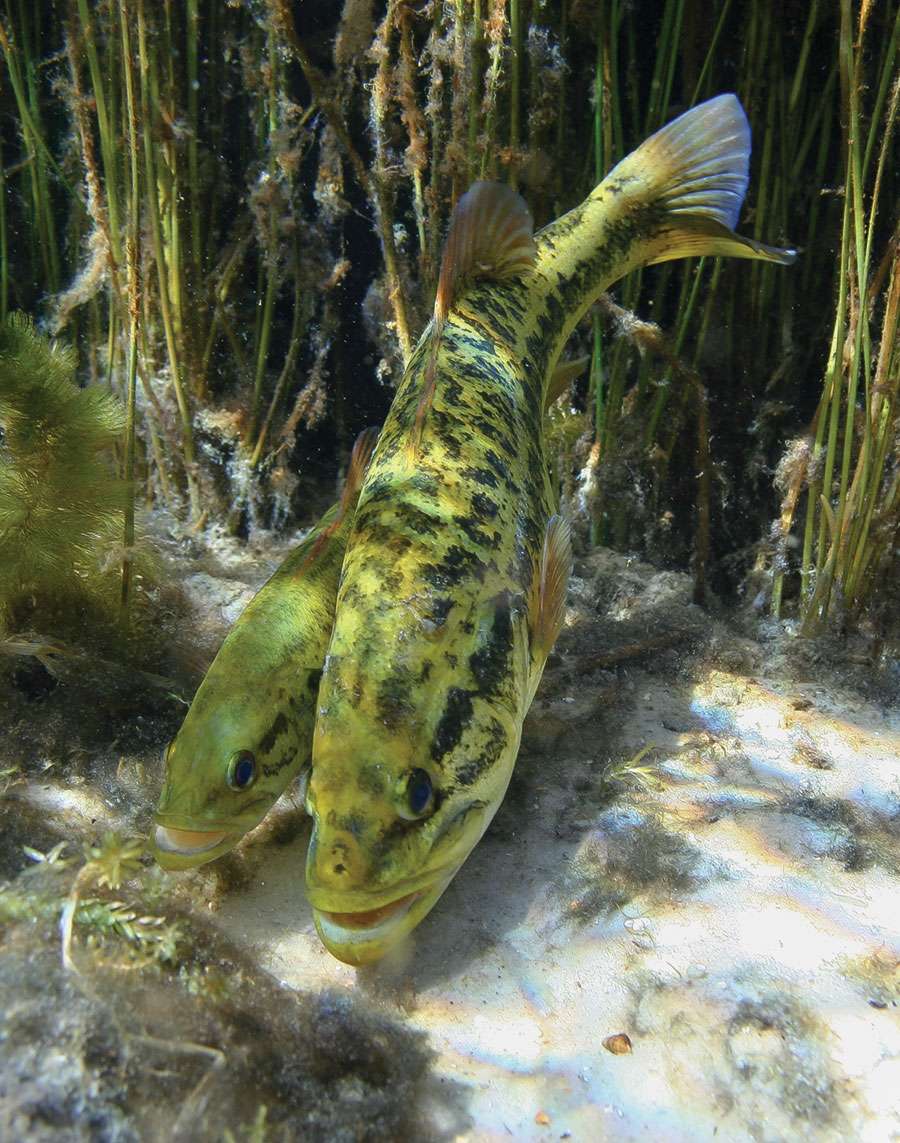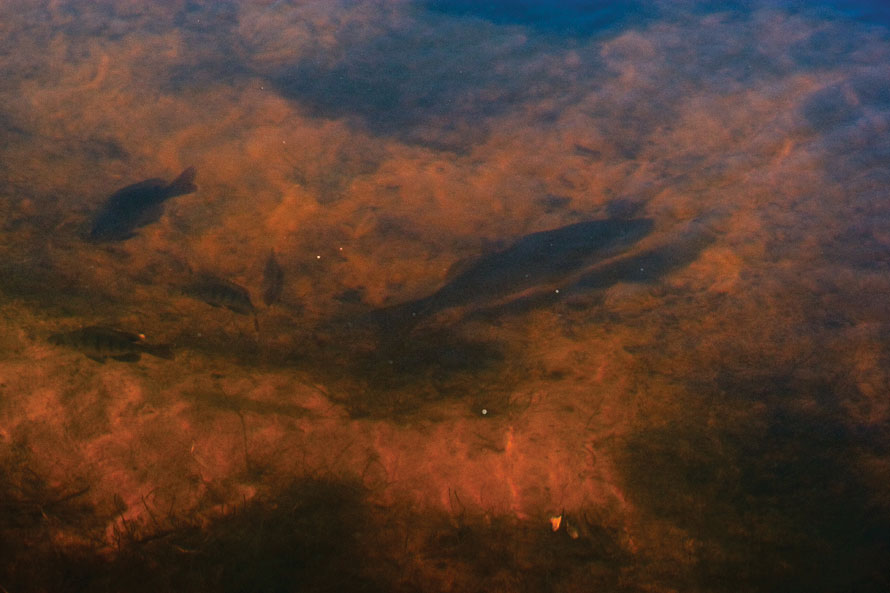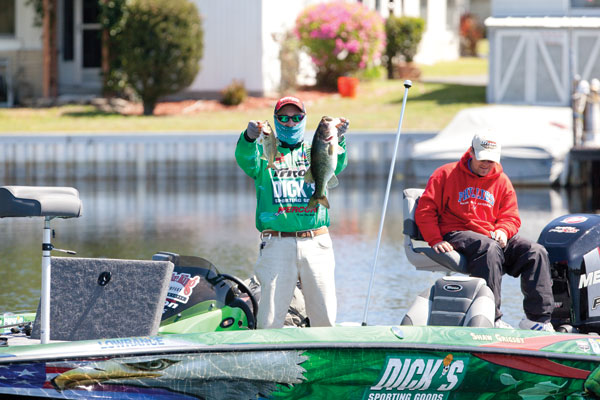
If there’s a better angler than Shaw Grigsby at catching bass off beds, he’s hiding under a rock somewhere. Use these tips from the sight fishing master to up your odds this spring.
It’s no coincidence that all nine of Shaw Grigsby’s career Bassmaster tournament wins have come during early January through mid-March. That’s the spawning season on Deep South lakes, and no one is better at picking off bedding bass than the veteran Florida pro.
Certainly, there are times when an inexperienced angler can catch a spawning largemouth, but not every fish is fooled so easily.
As a rule, tricking a big spawner into biting your lure will test your patience, if not your nerves. There’s an art to it, one which Grigsby has refined over the years. “There are days when the bass will thump anything you drop in the nest,” he says. “But more often than not, especially when several other anglers are targeting spawners, there is a small margin for error.”
Here are Grigsby’s best tips for stacking the odds in your favor when the bed bite is on.
1. Be patient
“This is the No. 1 factor in sight fishing, because sometimes it takes awhile to get a fish to eat,” he explains. “Sometimes you have to keep changing baits and trying different things to figure out the exact formula that will trigger a fish’s reaction. Most people don’t have enough patience.”
2. Keep your distance
It’s easier to catch fish that aren’t aware of your presence. Grigsby has caught 10-pounders that were within the shadow of his boat, but those experiences are rare.

“There’s a tendency for anglers to get close so they can see the bass better, but that can hinder you,” he says. “If you know where the bed is and can make out the outline of a fish, you’re better off staying back than looking the fish in the eye.”
Of course, polarized sunglasses make a huge difference, but so does boat position. Keep the sun to your back and set up where you have optimum view into the water and can see the bottom. A slight angular adjustment to either side can make a difference, too.
3. Move quietly
Keep a low profile in the boat and keep sudden body movements at a minimum. “Remember, a bass’ eyes are on top of its head and they’re very aware of things above them,” Grigsby says. “Eagles and ospreys are their predators, so any overhead movement puts them on guard.”

Avoid using the trolling motor unnecessarily, he adds, and if you have an anchor or Power-Poles, use them to help keep you at a distance and in position.
“One of the biggest keys to getting a bass to bite quickly is to make the cast before he knows you’re there,” insists Grigsby.
If you come upon a big female unexpectedly and startle her, mark the location, ease off and revisit the bed later. “When you do go back, stop ahead of time and make the longest cast you can,” he adds. “Cast beyond the target and drag it slowly into the bed.”
4. Don’t fish fast
Grigsby says many anglers put the bait in the nest area, shake it a few times, then pull it out. That may work at times, but it can also cause a fish to lose interest.
“A bedding bass gets jaded quickly,” he explains. “When she sees a bait constantly coming and going, she figures ‘It’s going to leave, so why mess with it?’ I keep the bait there as long as I can, shaking, wiggling and squirming before I take it away.”
5. Be choosy
Grigsby doesn’t invest a lot of time in pairs of fish that are in the act of spawning, such as when the male and female are rubbing, bumping and rolling.

“Unless you’re there at the very end of the ritual, it’s tough to get those fish to bite,” he says. “Mark the bed, then go back later. If they’re done, you stand a better chance of catching them.”
6. Study the fish
Experienced anglers know how to read bedding fish to determine their “catchability.” If a fish doesn’t leave the bed when it sees you, chances are you can catch it.
“If that fish takes off quickly and doesn’t come back immediately, it’s going to be tougher to catch,” Grigsby says. “If it’s a big fish and there are other anglers in the area — and you have the time — you can sit her out. Otherwise, mark the bed’s location and come back later with a more stealthy approach.”
If the fish noses up to the bait, you’re doing something right, even if it doesn’t take it.
“That is a positive sign the fish is interested and that whatever you’re doing is right,” he says. “Keep doing it, and keep putting it in the same place. You will get it to bite unless you spook her.”
Grigsby says there is generally a key spot of the bed in which the bass is more likely to bite if the lure gets there. You can usually tell by the interest she shows or how agitated she becomes when the bait hits a different spot.
7. Don’t overlook deep water
Not all bass spawn in shallow water. Grigsby says some of the most productive spawning areas he’s found lay deeper than most anglers look.
“Look as deep as your eyes will allow you to see,” he explains. “If I can see down to 6 feet, that’s where I start looking — from there to a foot of water.”
On extremely clear lakes, you may find bedding bass in 20 feet of water or more.
8. Search for ’em early
While biologists say 68 degrees is the optimum spawning temperature, bedding activity begins long before that. In fact, on some northern U.S. lakes, bass have been caught off beds in 50-degree water.
Grigsby says 60 degrees tends to be when activity picks up most on southern lakes, but he starts looking when the water hits 55 degrees.
“Follow the weather patterns closely,” he advises. “And by all means, start looking during full moon or new moon periods of early spring.”
9. Show ’em a variety
There’s no lure in your box that won’t catch bedding fish, but there are some that will catch them better.
Before Grigsby leaves the dock on a sight fishing day, he’ll have the following Strike King baits tied onto rods; Rage Tail Lizard (watermelon red or green pumpkin), with the tail dipped in chartreuse dye; Rage Tail Craw (white); Bleeding Bait tube (white with some red); 10-inch Thumper Worm (black/blue); and Hack Attack Jig (white) with a Rage Tail Craw (white).
“Lure color generally isn’t as important as is your ability to see the bait and know when the bass sucks it in,” he says. “That’s why I like lighter colors on small baits or will add some chartreuse to the tails of others.”
However, he says there are days when color or lure size make a difference. Baits that undulate or move with natural water currents while sitting still can aggravate a bass into biting. “If a fish is locked on there and big enough to fool with, keep experimenting with baits until you hit one that the bass seems to notice more,” Grigsby says. “It can be a nerve-racking process, but big ones make it worthwhile.”
10. Avoid heavy lures
Bass often spawn around wood and rocks. For that reason, Grigsby rigs his plastics with 3/8- or 1/2-ounce sinkers, preferring the lighter of the two in shallow water.
“Heavier weights can cause the lure to snag easier, and the last thing you want to do is disturb the bed environment,” he explains. “That’s a sure way to mess up your chances of catching a big fish.”
Originally published March 2012





